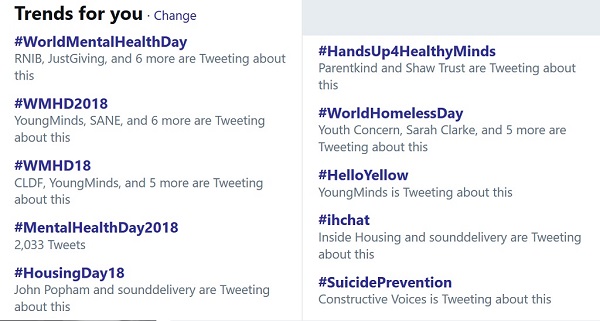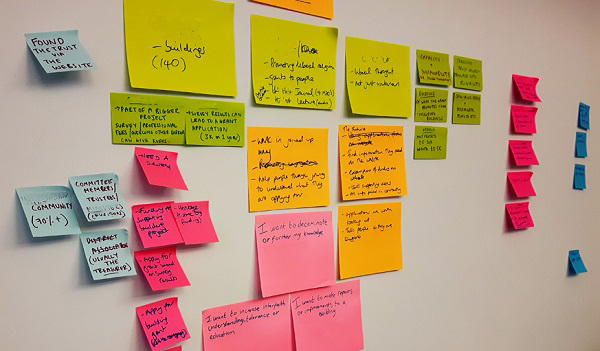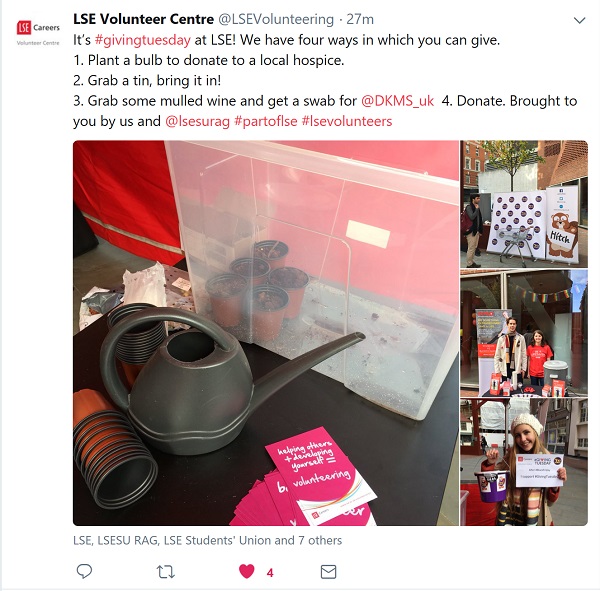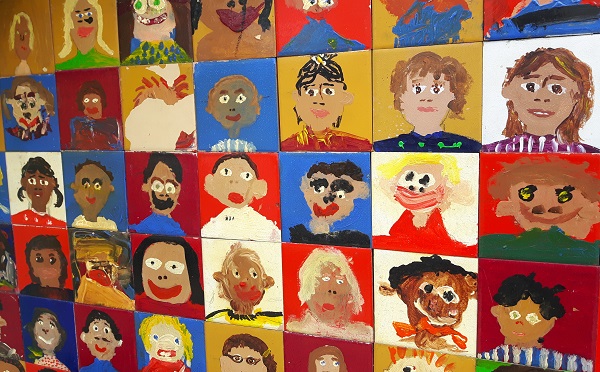Highlights this month: personal stories driving donations, lots of new campaigns, #BongForBrexit, #DollyPartonChallenge, the climate as a global risk.
January is such a long long month. Luckily there was lots of great charity content and good reads to get us through the dark days. Catch up here with some gems you might have missed.

How to use: Pick and choose links to read, or open in new tabs for later. Or bookmark this post. Even better, subscribe and get future round-ups direct to your inbox.
Content

- You’re full of it – new campaign from BHF about air quality. This thread includes branded gifs (also seen on billboards) plus a quiz and link to the campaign site where you can check the air quality where you live.
- Great reactive comms from Generation Rent. Welcome to the world of renting Harry and Meghan.
- 2019 in review – nice video from British Transport Police Specials and I like this end of year thank you video from Oxfam – ‘with your help, people have changed their lives’.
- Examples of New Year’s Resolution comms from across the sector.
- New #ThisGirlCan video. 920k views!
- Action Aid shared the numbers from their Gifts in Action.
- Greenpeace created a quiz thread about being an environmentally conscious shopper.
- Friends of the Earth thread about ecoanxiety.
- What have vegan sausage rolls got to do with Universal Credit? Helen Barnard of JRF shares in this topical vlog post.
- New campaign from national poverty charity Turn2Us about appliance poverty – Living Without.
- Beautiful animation and poems for The Mayhew’s #StayInseparable campaign.
- Jo’s Cervical Cancer Trust respond to conflicting stories in the news about cervical cancer.
- Books Trust are great at finding thorny issues to tackle. Are you a book vandal?
- Together we can stop visible hate – new campaign from Changing Faces.
- Don’t be dogfished. Dogs Trust campaign to raise awareness about puppy sales.
- Is eating chicken bad for the planet? New explainer videos from WWF. See also How have you helped fight the Australia fires?, a thank you and update.
- Nice use of a Moment from Guide Dogs.
- Top responses to the #DollyPartonChallenge! This one from The Vagina Museum was my favourite.
- Nice promo film from the National Trust to celebrate their 125th birthday. ‘We all need quiet. We all need beauty. We all need space.’
- The science behind Blue Monday – a thread from Rethink.

Comms
- Public sector comms, PR and digital predictions for 2020 – Dan Slee.
- Content style guide – how to write for digital NHS services. I love a juicy style guide! Listen to Radio 4’s Word of Mouth episode about NHS language too.
- Language matters. Think carefully about the words you use to describe the people you support. Join in with the #SayItBetter campaign to spread respect, kindness and empathy.
- Why We Are With You – designing a name and brand that makes it easier for anyone to ask for help. Great post explaining the thinking behind Addaction’s rebrand and name change due to launch in late February – Laura Bunt.
- Last year Trussell Trust’s choose your own adventure Twitter thread about Universal Credit generated 350k impressions. Shifting narratives on social: choose your own adventure highlights real issues – Charity Comms.
- The #DollyPartonChallenge magnified the best and worst of museum social media manager life – Lori Byrd-McDevitt.
- Nine ways to spread positivity and #ReclaimSocial professionally and personally – Tereza Litsa for Charity Comms.
- British Red Cross are on TikTok with their new #ShopDrop challenge. See also #PEtBFF from Blue Cross and #MusicShapedMe from Youth Music. Dan Slee shared some useful tips if you are thinking of taking on TikTok.
- When was the last time you shared your mission / purpose on social media? Here’s one from Parkinson’s UK.
- Love these alternative sympathy cards as shared by Zoe Guy. Bereavement cards than don’t suck, produced by Let’s Talk About Loss are already on their second reprint.
- If you want to know what prisons are really like, watch BBC’s The Choir…. Philippa Budgen
- Top tips on telling children’s stories – Catherine Raynor of Mile91.
- Ever used Google Street View to tell a story? This tweet about a woman finding her grandfather on SV prompted a large response.
- Finding the best time to post on social media – Brendan Rodgers for Lightful.
- Have you used any of the new emojis? This thread introduces the 117 new emoji for 2020. BHF are big fans of one!
- Writing a great social media bio for your brand – Social Media Today.
- Bluffer’s guide to framing 2020 – Sho Konno. Includes lots of examples.
- Crisis comms – responding to a fundraising boost. How Epilepsy Society responded when a Twitter thread went viral. To date the original tweet has had 32k likes.
Digital – strategy, design, culture

- Digital 2020: 3.8 billion people use social media – detailed stats and trends on global digital use from we are social.
- Lightful predicts digital trends for 2020 – Tereza Litsa.
- Digital trends for the Church in 2020 – The Church of England’s tips to help churches use digital comms.
- Pinterest launch wellbeing resources.
- Is the charity sector prioritising digital ethics? Charity Digital News.
- Supporting more people in more organisations: what the digital fund will help us achieve – Megan Griffith Gray of NCVO.
- Bookmark empower’s charity digital and tech for good events calendar 2020.
- Catch up with Charity Comms’ Unlocking the potential of your data seminar. Including this thread about creating a healthy data culture using Street League as an example.
- The state we’re in – Helping colleagues (who aren’t interested in tech) understand the health of an IT estate. Polly Thompson from 2018.
- If high street shopping was like online shopping – great video from BBC Wales.
- Should we use a microsite – flowchart from Dan Brown. See also Should this go on the homepage.
- Creating focus using Design Sprints at Shelter – CayleeFarndon Taylor.
- NPC Labs: Why we’re embracing open working at NPC.
- Digital Candle – new platform from Matt Collins connecting charity leaders with digital experts who can give an hour’s phone time. Book your call or volunteer your services.
- Monthly accessibility tip 1: Accessible images on social media: what every government agency needs to know – Kate Rawlins for Helpful Digital.
- Accessibility tip 2: 7 ways you can make your Twitter feed more accessible – The Big Hack. Lots of useful tips here.
- PDFs and accessibility – a thread by Jack Garfinkel of Scope.
- ‘I wish we could connect on this level.’ Memes still aren’t accessible to people who are blind. What’s being done about it? Rachel E Greenspan for Time.

Fundraising
- There were a few #BongForBrexit anti-fundraisers. This from Bloodwise was widely shared.
- Aaron smashed his £3000 target for Mencap and is almost at his £9000 target. He wanted to prove people wrong.
- CAF shared 5 myths about giving to charity.
- Combat Stress announced a service redesign – “Whilst we have adapted to meet the demand of veterans, we are now faced with scaling back our workforce and services nationwide and have begun a consultation with staff on our proposals.”
- Does your charity do thankathons to connect with supporters? See The Mines Advisory Group (MAG).
- The global impact of Giving Tuesday (issuu report).
- St Johns Hospice supported their patient Keith’s dying wish to hit his £500,000 fundraising target for RNIB. Known as Sootyman, Keith had just £10k to go. The target has now been reached and excess will be donated to the hospice.
- Top 20 charity shop window displays.
People and organisations
- Australian Red Cross criticised over how they were spending donation money given in response to the bushfires.
- Time to Change movement recognised as one of the top public health achievements of the decade.
- Making Change Happen: An emerging approach to planning for impact – Social Finance.
- How to be a better white person in 2020 – Michael Harriot for The Root.
- New year, new decade: ten Change Collective resolutions for equality, diversity and inclusion – Elizabeth Balgobin for IoF.
- Where are England’s charities? asks Dan Corry of NPC.
- Thinking of going freelance? Two good-read threads. First Heather Parry shares useful advice about tax returns and running a business. Second, Kirsty Marrins wrote this blog post about managing your mental health and wellbeing as a freelancer. Plus this from Work Notes.
Climate crisis

- The 2020 Global Risks Report from World Economic Forum. All five of the top risks by likelihood and three by impact are climate related.
- NCVO’s Road Ahead report included climate change and activism as one of the social drivers in 2020.
- The climate crisis: the five shifts the sector needs to make in response – Kirsty McNeill of Save the Children for IoF. “Every single one of us is – or has the potential to be – a leader in the climate movement.”
- National Trust to be carbon neutral by 2030.
- The Natural History Museum declare a planetary emergency.
- Culture has a carbon footprint, and data matters – Museums and Heritage Advisor.
- Local newspapers featured climate change on their frontpages as part of the #Do1Thing campaign.
- What can I do about climate change? – Woodland Trust.
- How to make your events more sustainable – Just Giving.
- Village halls responding to the climate crisis – Zurich article for Village Halls Week.
And finally….
- 51k likes for photoshopped lifeboats on paintings by Andy Doe.
- Quick quiz – which railway station was the UK’s most visited in 2018-19 with 94million entries and exits? ORR share the stats.
- University of Liverpool found an unusual cheesy bookmark.
Your recommendations
What did you read, watch or launch this month? Please add your links in the comments.
Can I help you?
Get in touch if I can help you with content planning, training or strategy. I work with charities of all shapes and sizes. I can help give your comms or digital processes a healthcheck and ideas injection.
——
Did you miss December’s round-up? Catch up with more good reads!









































